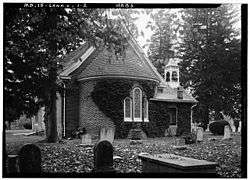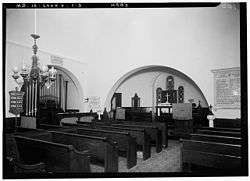St. Paul's Church (Fairlee, Maryland)
|
St. Paul's Church | |
 St. Paul's in 1936 | |
  | |
| Location | 7579 Sandy Bottom Rd., Chestertown, Maryland |
|---|---|
| Nearest city | Chestertown, Maryland |
| Coordinates | 39°11′11″N 76°10′47″W / 39.18639°N 76.17972°WCoordinates: 39°11′11″N 76°10′47″W / 39.18639°N 76.17972°W |
| Area | 12 acres (4.9 ha) |
| Built | ca. 1712 |
| NRHP reference # | 80001820[1] |
| Added to NRHP | June 6, 1980 |

St. Paul's Church, is an historic Episcopal church located near Chestertown, Kent County, Maryland
It is the earliest existing Episcopal church building on the Eastern Shore of Maryland, except for the restored Trinity Church, Church Creek and one of the first parishes established by the Colonial Assembly in 1692 for the dissemination of the Church of England throughout the province.[2] St. Paul's Parish, Kent was one of the original 30 Anglican parishes in the Province of Maryland.[3][4]
History
St. Paul's Parish was established in 1692 as one of the original 30 Anglican parishes in the Province of Maryland. The first church was a simple frame building which, by 1711, had deteriorated beyond repair. Plans were made for a brick structure to cost, in the "currency" of the region and day, 70,000 pounds of tobacco![3]:2,5
Opened in 1713, St. Paul's is currently the oldest continuously used Episcopal church building in Maryland. It measures 30 by 40 feet (9.1 m × 12.2 m) with a semicircular apse on the east gable where musicians would have sat. The floor was not raised as it is today, nor was there an altar. People sat in “box pews” on chairs and faced the pulpit in the middle of the north wall. The main door was on the south wall.
A colorful cleric of the colonial period was the Revd. James Sterling who served from 1740-63. A poet, playwright, socialite, and entrepreneur, he was also customs collector for Chestertown.
In 1766, the Vestry House, where church meetings were held, was built. Once common in Maryland, this is one of only two surviving (the other in Perryman).
When the Revd. Robert Read returned to Virginia in 1777, St. Paul's was served part-time by the Revd. Dr. William Smith of Emmanuel, Chestertown. Dr. Smith embraced American Independence and was instrumental in organizing former Church of England parishes into what became “The Episcopal Church.”
His successor, in 1785, the Revd. Colin Ferguson, was the first priest ordained by the Rt. Revd. Samuel Seabury, the first bishop of The Episcopal Church.
St. Paul's, however, declined with the upheavals caused by the war and the contemporary rise of Methodism. An 1806 report shows nine Methodists for every Episcopalian in the area.
By 1840, membership had dwindled to 13 families. Fortunately, this was to be the low point in parish fortunes. The 1840s proved to be years of growth as dedicated clergy and laity worked to reach people with no religious affiliation. A Sunday School was established and Free Blacks welcomed.
It was during these years that the square pew boxes were replaced by fixed benches (still in use) facing east. The south entrance was bricked up and a robing room added. In keeping with “Oxford Movement” influence, the worship focus now became the communion table, permanently placed in the apse behind an altar rail.
The parish was torn by the Civil War with men on both sides of the conflict. Despite the differences, however, the church, served by the Revd. Andrew Sutton, Jr., was able to minister to all.
During these years, the church acquired the stained-glass window behind the altar. This window incorporates panels in the black and gold colors used by Northern sympathizers with the red and white of Southern sympathizers. In the centre, a symbol of the Union 12th Corps, in which Eastern Shore Maryland regiments served, is joined with the "Cross Bottony" used by Maryland regiments in Confederate service and surmounting it is a dove representing the desire for peace.
The Revd. Sewell S. Hepburn arrived in 1874 and stayed until 1881. While he was locally known for his ministry, his granddaughter, Katharine Hepburn, achieved some wider fame of her own!
In the late 19th/early 20th c., a stone altar replaced the communion table and the floor of the apse was raised. A pipe organ and choir stalls were installed with a choir room addition (1908). The small window over the west door was greatly enlarged.
The economic difficulties which plagued St. Paul's during the latter part of the 19th c. reflected those of rural America in general — bank and crop failures. A succession of clergy were called, but lack of funds led to their eventual departures.
An exception to this pattern was the Revd. Christopher Denroche who arrived in 1892 after thirty years of ministry in his native Canada. He stayed until his death in 1906 and never once received his full salary. It was Fr. Denroche who instigated the plan to commemorate Kent County's only War of 1812 action with building a memorial for the Battle of Caulk's Field (Aug. 30th, 1814). It stands today.
Another rector who brought a wealth of previous experience was the Revd. William Wyllie who took up his duties at the age of sixty-five. Born in Scotland, he had served in South Dakota, New Mexico, Arizona, and Santo Domingo.
Having come at the depth of the Great Depression, the vestry minutes of 1939 record a "rising vote of thanks" "for his economic administration of the affairs of the parish."
The Revd. John Nelson succeeded him in 1948 and was present during two major building programs — the Parish Hall and Rectory (clergy hitherto had lived in Fairlee or Chestertown).
Baltimore architect Bryden Hyde designed these buildings, replicating features found in Annapolis' Hammond-Harwood House and Chestertown's Hynson-Ringgold House. He also painted the heraldic arms of the founding families above the Parish House fireplace. Mr. Hyde's ancestor, the Revd. Stephen Bordley, had been St. Paul's second priest (1697-1709) and had married into the Hynson family.
The Revd. George Taylor oversaw the burgeoning of the Sunday School in the "Baby-Boomer" years. His excellent work in the parish was curtailed in 1966 when he was elected to be Bishop of Easton, an office to which he brought distinction.
The church was placed on the National Register of Historic Places in 1980.
In 1992, the parish celebrated 300 years with a festival year of events including a visit from Canon John Sausmarez of Canterbury Cathedral in Kent, England.
Membership growth led to an expansion of the Parish House with a classroom / office wing dedicated in 1999.
References
- ↑ National Park Service (2010-07-09). "National Register Information System". National Register of Historic Places. National Park Service.
- ↑ "Maryland's National Register Properties: St. Paul's Church". Maryland Historical Trust. 2008-10-05.
- 1 2 Mrs. Owen Selby and Michael Bourne (December 28, 1978). "National Register of Historic Places Inventory/Nomination: St. Paul's Church / Old St. Paul's" (PDF). Maryland Historical Trust. Retrieved April 6, 2017. With two maps and four photos.
- ↑ "St. Paul's, Kent: About". Retrieved April 6, 2017.
Further reading
- A Tricentennial History of St. Paul's Church, Kent, available for purchase at St. Paul's Parish, Kent
External links
- St. Paul’s Parish, Kent, official website
- St. Paul's Church, Kent County, including undated photo, at Maryland Historical Trust
- St. Paul's Episcopal Church, Sandy Bottom Road, Sandy Bottom, Kent, MD at the Historic American Buildings Survey (HABS)
- St. Paul's Episcopal Church, Vestry House, Sandy Bottom Road, Sandy Bottom, Kent, MD at HABS

